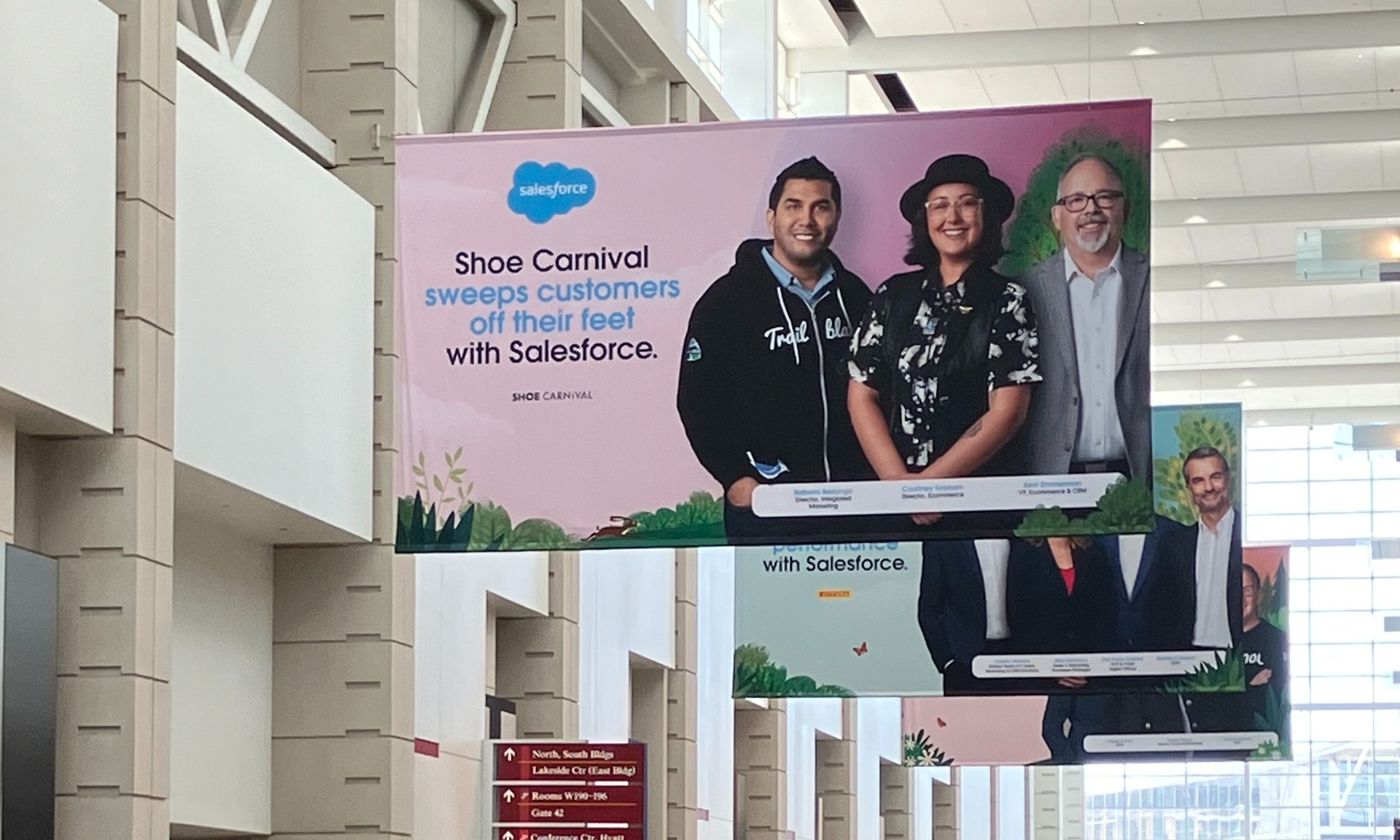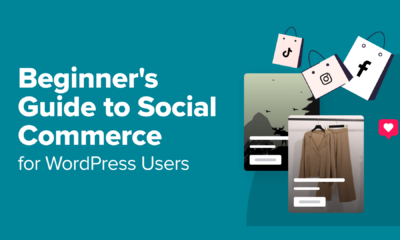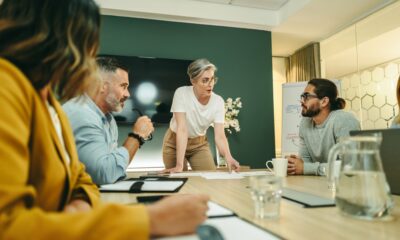MARKETING
The Ultimate Guide to Relationship Marketing

Did you know that customer retention has been found to be even more critical to your company’s success than customer acquisition? Frederick Reichheld of Bain & Company found as little as a five percent increase in customer retention can result in an increase in company revenue by 25-95%.
In fact, no matter if you’re a team of one or leading a scaling enterprise, you can build customer relationships with your existing audience without the typical costs associated with acquiring new customers. The key is strategic relationship marketing.
What is relationship marketing?
Relationship marketing refers to the marketing strategy of cultivating more meaningful relationships with customers to ensure long-term satisfaction and brand loyalty. Relationship marketing isn’t about short-term wins or sales transactions — instead, it focuses on delighting customers for the long haul.
Especially since, as Adobe learned, returning customers spend more than newer customers. Why? Because existing customers understand the value of your products and services and they’re invested loyally in your brand. If a customer feels satisfied with their interaction with you, they’re more likely to turn to your business for their needs, again and again.
“But isn’t all marketing relationships marketing?” Not exactly. Some marketing strategies are solely about gaining traffic and conversions to get potential customers into the customer flywheel. From there, you’ll have even more marketing tactics that get that potential customer to make their first purchase like customer acquisition.
The perfect time to start a relationship marketing strategy is when the customer has made a purchase (or several). Your goal with relationship marketing is to get these new customers to become brand-loyal patrons of your business. To do that, you’ll want to take a personalized approach to client retention and become integrated into their lives in a way that feels natural and genuine.
What are the benefits of relationship marketing?
Like many forms of white-hat marketing tactics, there are various benefits to leveraging relationship marketing strategies for your brand. But, when properly executed, the most impactful ways to improve your business through relational advertising include:
So, let’s take a look at some relational advertising examples from firms that adopt a relationship marketing strategy to attempt to retain existing customers. Then, we’ll explore how you can implement a strong relationship marketing strategy today.
Relationship Marketing Examples
- Capital One
- Delta
- Fairway Independent Mortgage Corporation
- Fenty
- GE
- Domino’s
- Panera
- Marriott
- ArmorSuit
1. Capital One

Capital One understands its customers deeply — all the way down to the small inconveniences that plague them most. One of those annoyances is the long TSA line at the airport.
Capital One reimburses all venture cardholders up to $100 when they pay the TSA PreCheck fee. All they have to do is pay for it with their Capital One credit card.
TSA PreCheck expires after five years, and this benefit applies every time the cardholder wants to renew their PreCheck status. Here, Capital One is demonstrating its brand value to its current audience through:
- Offering a perk that’s universally appealing to their base — free money
- Mitigating a prevalent issue customers face with a long-term resolution
This benefit speaks to a relevant pain point for Capital One customers and makes keeping an account open with Capital One well worth it in the long run.”font-size: 1.5rem; font-weight: 500;”>
2. Delta

Speaking of TSA lines, as the oldest operating airline in the United States, Delta, is no stranger to relationship marketing strategies that preserve the brand loyalty of their customers.
One of their most effective methods remains the airline’s customer loyalty program, the SkyMiles program. Customers who sign up for this program earn “miles based on the amount of money they spend with Delta, which can then be redeemed for future travel purchases like airfare, seat upgrades, and more.
To expand their miles offering, they’ve also partnered with credit card companies like American Express to offer bonus miles and accruement when customers use their SkyMiles credit cards to make purchases. In fact, if you qualify for the Amex Reserve card you will also receive complimentary access to the Delta Sky Club. Within this lounge, you can enjoy unlimited free meals, snacks, and drinks on the day you take a Delta flight.
By employing these relationship marketing strategies, Delta has been able to:
- Build a loyal customer base that continues to choose them over competitors
- Seamlessly integrating their business into the lives of their customers through platforms they utilize daily
As a result, their marketing strategy is paying off — they were recently ranked number 1 by J.D.Power for customer satisfaction across North American airlines.
3. Fairway Independent Mortgage Corporation

Buying a home is one of the most important decisions a consumer can make. During the purchasing process, buyers typically shop around for the lowest rate, but they’re also shopping for a reliable team that will make the process as smooth as possible.
Fairway Independent Mortgage Corporation is a great example of a business that takes the relationship marketing approach for its customer retention plan. For example, I received a birthday email from Fairway when I needed to make a lending decision.
In addition to that, the loan consultant was sure to send over some marketing documents with their value proposition and benefits for me as a buyer. Their relationship marketing strategies improved my experience as a consumer by:
- Retargeting audiences via email on a major life event like a birthday
- Enforcing their service offering with valuable supporting documents
Their retention strategies show that the company is committed to being responsive, respectful, helpful, and most importantly — closing on time. This is a recipe for success in the mortgage industry as referrals are the “bread and butter of any successful loan officers business.”
4. Fenty
When international singer and actress Rihanna made her professional pivot to a businessperson in the Fashion & Beauty industry, the “Talk That Talk” vocalist had also kept people talking about what would come of her brand, Fenty, once it made its debut.
Well in a market already saturated with celebrity beauty and fashion ventures, Fenty distinguished itself to the point of changing the industry landscape through inclusivity. But how? Amongst many examples of marketing strategy, Fenty’s relational advertising tactics remain supreme.
For instance, the popular Fenty Beauty foundation includes shades such as “Vanilla” capturing some of the palest tones, and “Espresso” embracing some of the deepest. At the same time, her Savage X Fenty lingerie sends messages of size inclusivity and body positivity to their customers through the wide range of sizes (from XS to 4XL) they offer to all. Models and celebrities of all shapes and sizes model the clothing during the Savage X Fenty Show streamed on Amazon.
Customers are also able to sign up with a membership program that allows customers to get first dibs on product launches, exclusive content, and access to VIP-only sales. By applying these strategies for customer retention, Fenty has been able to:
- Presenting the brand as a solution and product for all through inclusivity
- Showcasing their messaging globally to connect with consumers across borders
By sending an impactful brand message to their audience, that they back up with their product offerings, Fenty is able to stand out from the crowd and create its own.
5.GE

Relational advertising is ultimately about offering both new and existing customers valuable content regardless of where they are in the buyer’s journey.
GE does a great job of diversifying its content– and the platforms on which it promotes– to ensure its examples of relationship marketing strategy satisfy as many people as possible. For instance, GE created two sponsored podcasts in the sci-fi genre. It seems strange, but GE positions itself as an “inventor of the future of industry,” so it makes sense that the company might dabble in the world of what-ifs in the sci-fi genre.
Additionally, the company has a popular YouTube channel that features historic, innovative stories from the perspective of GE employees. This is because good relationship marketing should appeal to the first-time viewer as powerfully as it appeals to your long-term customers to ensure your customers grow with you over time.
By consistently offering a diverse range of quality content, GE shows its desire to satisfy its long-term customers even at the expense of short-term wins.
6. Domino’s
In the past couple of years, Domino’s has taken its fair share of risks with its relationship marketing strategy for the sake of innovation and improvement. This includes a series of ads called Pizza Turnaround, in which they showcased a series of negative customer reviews, before promising a new and improved recipe.
These self-deprecating ads appeal genuinely to viewers but go against any traditional sales playbook… which is why they work. By admitting an area of opportunity, Domino’s re-invented its brand as transparent and honest — and who wouldn’t want to buy from a company like that?
Domino’s has also done a fantastic job tapping into its digital audience. In fact, 70% of Domino’s sales are now through digital channels.
Ultimately, Domino’s has taken innovative steps to cultivate a loyal, long-term customer base through:
- Slowly and strategically re-inventing their product and their brand
- Engaging with their customers on their favorite digital platforms
Plus, the best part is you can too.
7. Panera
 Panera’s commitment to health and convenience has resulted in 40 million Panera loyalty members.
Panera’s commitment to health and convenience has resulted in 40 million Panera loyalty members.
In 2014, Panera issued a statement promising its customers it would remove all artificial flavors, sweeteners, and preservatives from all Panera products by the end of 2016. The company remained transparent throughout the process, publishing progress reports to demonstrate a level of accountability and transparency to its customers.
Undoubtedly, it was a risky decision to admit they’d previously used unhealthy ingredients in their food — but their brand promise paid off big-time in 2016 when the brand could officially say “100% of our food is 100% clean.”
Additionally, the brand focuses on building customer relationships through personalization. For instance, Panera alerts loyalty members about new food offerings they feel will meet members’ “flavor profile” based on past purchases.
- Making a brand promise and fulfilling this pledge to their customers
- Improving the quality of their products for customer satisfaction
The company also meets its customers where they are — starting an online grocery business due to the COVID-19 pandemic. Panera even offers home and business delivery, rapid pickup, and catering to improve customer service.
8. Marriott
 Undoubtedly, a 35-minute film is not the most traditional avenue a hotel can take when it wants to increase sales — and yet, that’s exactly what Marriott chose to do with their film, “Two Bellmen Three“.
Undoubtedly, a 35-minute film is not the most traditional avenue a hotel can take when it wants to increase sales — and yet, that’s exactly what Marriott chose to do with their film, “Two Bellmen Three“.
This film enables Marriott to appeal to a younger demographic and build brand awareness on dominant platforms like Snapchat. Best of all, their retention marketing content rarely resembles an advertisement and is typically focused on providing an audience with fun, or helpful, information on various travel destinations.
9. ArmorSuit

ArmorSuit’s warranty policy begins like this — “Most warranties are limited to 30 days or one year, but with our Lifetime Replacement Warranty, our customers can request for a replacement screen protector for a lifetime. This way, you never need to purchase a whole new kit when a replacement is needed.”
This way, you never need to purchase a whole new kit — a phrase you’ll likely never hear in traditional sales transactions. While it might seem ridiculous to offer a lifetime warranty, it makes sense with retention strategies for two central reasons:
- Maintaining customer satisfaction with their products
- Building strong relationships with their base for the long term
Now when their customers need other products related to tech, they’ll most likely check out ArmorSuit’s website first.
Next, let’s explore how you can create a strong relationship marketing strategy for your own business.
Relationship Marketing Strategy
- Provide personalized, focused customer service.
- Engage with the customer where they are.
- Incorporate technology to work more effectively.
- Offer incentives and rewards for customer loyalty.
- Create valuable content that tells a compelling story.
- Collect feedback regularly.
- Concentrate on building customer relationships for the long-term.
1. Provide personalized, customer-focused service.
When you’re creating a relationship marketing strategy and engaging with your customers, your primary concern should never be focused on your product or service. Instead, your concerns should always revolve around the customer — So ask yourself:
- Would the customer want to see this ad?
- Would the customer be excited about this Instagram post?
- Does our new product delight the customer?
Additionally, you must create channels for direct support when your customers need help. Perhaps your retention strategies include implementing a Facebook Messaging Bot for service-related concerns. Alternatively, maybe you answer your customer’s questions via Instagram DM. By meeting your customers on platforms they use most, you’re proving your willingness to help them wherever that takes you, a tenet of successful customer retention.
2. Engage with the customer where they are.
The reason Marriott’s strategy works is not only because of the content they create — it’s also where they post that content. Creating videos specifically for Snapchat is a great marketing strategy example because it enables Marriott to appeal to a younger demographic on a platform already popular with that audience.
Research which platforms are most popular for your ideal demographic. By reaching out to them through their preferred channels, you’re demonstrating strategy examples that embody helpfulness and understanding. It’s this sentiment that will encourage users to interact with your brand.
3. Incorporate technology to work more effectively.
Technology might seem counterintuitive to building organic relationships that are personalized, but it can be the key to solving customer pain points. As your company grows, it’ll become increasingly more difficult to connect one-on-one with each customer and continue keeping customers satisfied.
Using an automated marketing system can ensure that every customer receives communication from your business and has the opportunity to engage. Tools like HubSpot’s Marketing Hub can automate workflows and email cadences so that you never miss a customer milestone.
4. Offer incentives and rewards for customer loyalty.
To cultivate a long-term relationship with your customers and create lasting brand loyalty, continue engaging with customers even after they’ve purchased a product. Consider what you can offer them once they’ve become customers — perhaps they can get a discount on additional products, or receive personalized recommendations based on their preferences.
By creating a loyalty rewards program, Panera’s customer relationship marketing continues to incentivize its customers to purchase additional products and slowly forms a more meaningful relationship by gathering information about each customer. They then use that information to offer unique suggestions depending on their individual food preferences.
5. Create valuable content that tells a compelling story.
If a customer has already purchased your product, they don’t need to see additional product advertisements to become brand loyalists — instead, they need to feel your business offers value regardless of their purchase intent. Marriott’s film isn’t meant to immediately convert a viewer into a paying customer. Firms that adopt a relationship marketing strategy attempt to continuously provide quality to their customers. So Marriott’s purpose is to increase brand awareness. Therefore, down the road, when that viewer is ready to book a hotel for an upcoming trip, they’ll remember the compelling film they saw once and think of Marriott.
6. Collect feedback regularly.
A relationship works two ways — to truly develop a meaningful connection with your customers, then, you must ask for feedback:
- What do they want to see from your brand?
- What do they like about your product?
- What do they wish you wrote about on your blog?
This information improves your relationship marketing strategy so you best fit the needs of your specific audience.
7. Concentrate on building customer relationships for the long-term
There will always be a time for marketing strategies like Pay Per Click ads that generate the instant sales gratification of proper product promotion– but this moment isn’t one of them.
In order to foster meaningful relationships that cause your customers to truly connect with your brand, you have to create purposeful content and deliver quality service to guide them throughout the relationship. By doing so, you will establish brand trust, show your audience you’re not just in it for a quick buck, and demonstrate your commitment to their success, not just your own.
Play the Long Game With Relationship Marketing
There’s a time and place for quicker marketing strategies wins and they’re paramount in hitting goals and KPIs each quarter. However, your marketing, sales, and service teams work much better together at playing the long game. Relationship marketing won’t score you consistent quick wins that you can measure with hard numbers on a dashboard. But you’ll find that staying the course and nurturing the customer through relational advertising will yield happier and more loyal brand advocates for quarters to come.
Editor’s note: This post was originally published in February 2019 and has been updated for comprehensiveness in May 2022.

MARKETING
YouTube Ad Specs, Sizes, and Examples [2024 Update]
![YouTube Ad Specs, Sizes, and Examples [2024 Update] YouTube Ad Specs, Sizes, and Examples](https://articles.entireweb.com/wp-content/uploads/2024/06/YouTube-Ad-Specs-Sizes-and-Examples.jpg)
Introduction
With billions of users each month, YouTube is the world’s second largest search engine and top website for video content. This makes it a great place for advertising. To succeed, advertisers need to follow the correct YouTube ad specifications. These rules help your ad reach more viewers, increasing the chance of gaining new customers and boosting brand awareness.
Types of YouTube Ads
Video Ads
- Description: These play before, during, or after a YouTube video on computers or mobile devices.
- Types:
- In-stream ads: Can be skippable or non-skippable.
- Bumper ads: Non-skippable, short ads that play before, during, or after a video.
Display Ads
- Description: These appear in different spots on YouTube and usually use text or static images.
- Note: YouTube does not support display image ads directly on its app, but these can be targeted to YouTube.com through Google Display Network (GDN).
Companion Banners
- Description: Appears to the right of the YouTube player on desktop.
- Requirement: Must be purchased alongside In-stream ads, Bumper ads, or In-feed ads.
In-feed Ads
- Description: Resemble videos with images, headlines, and text. They link to a public or unlisted YouTube video.
Outstream Ads
- Description: Mobile-only video ads that play outside of YouTube, on websites and apps within the Google video partner network.
Masthead Ads
- Description: Premium, high-visibility banner ads displayed at the top of the YouTube homepage for both desktop and mobile users.
YouTube Ad Specs by Type
Skippable In-stream Video Ads
- Placement: Before, during, or after a YouTube video.
- Resolution:
- Horizontal: 1920 x 1080px
- Vertical: 1080 x 1920px
- Square: 1080 x 1080px
- Aspect Ratio:
- Horizontal: 16:9
- Vertical: 9:16
- Square: 1:1
- Length:
- Awareness: 15-20 seconds
- Consideration: 2-3 minutes
- Action: 15-20 seconds
Non-skippable In-stream Video Ads
- Description: Must be watched completely before the main video.
- Length: 15 seconds (or 20 seconds in certain markets).
- Resolution:
- Horizontal: 1920 x 1080px
- Vertical: 1080 x 1920px
- Square: 1080 x 1080px
- Aspect Ratio:
- Horizontal: 16:9
- Vertical: 9:16
- Square: 1:1
Bumper Ads
- Length: Maximum 6 seconds.
- File Format: MP4, Quicktime, AVI, ASF, Windows Media, or MPEG.
- Resolution:
- Horizontal: 640 x 360px
- Vertical: 480 x 360px
In-feed Ads
- Description: Show alongside YouTube content, like search results or the Home feed.
- Resolution:
- Horizontal: 1920 x 1080px
- Vertical: 1080 x 1920px
- Square: 1080 x 1080px
- Aspect Ratio:
- Horizontal: 16:9
- Square: 1:1
- Length:
- Awareness: 15-20 seconds
- Consideration: 2-3 minutes
- Headline/Description:
- Headline: Up to 2 lines, 40 characters per line
- Description: Up to 2 lines, 35 characters per line
Display Ads
- Description: Static images or animated media that appear on YouTube next to video suggestions, in search results, or on the homepage.
- Image Size: 300×60 pixels.
- File Type: GIF, JPG, PNG.
- File Size: Max 150KB.
- Max Animation Length: 30 seconds.
Outstream Ads
- Description: Mobile-only video ads that appear on websites and apps within the Google video partner network, not on YouTube itself.
- Logo Specs:
- Square: 1:1 (200 x 200px).
- File Type: JPG, GIF, PNG.
- Max Size: 200KB.
Masthead Ads
- Description: High-visibility ads at the top of the YouTube homepage.
- Resolution: 1920 x 1080 or higher.
- File Type: JPG or PNG (without transparency).
Conclusion
YouTube offers a variety of ad formats to reach audiences effectively in 2024. Whether you want to build brand awareness, drive conversions, or target specific demographics, YouTube provides a dynamic platform for your advertising needs. Always follow Google’s advertising policies and the technical ad specs to ensure your ads perform their best. Ready to start using YouTube ads? Contact us today to get started!
MARKETING
Why We Are Always ‘Clicking to Buy’, According to Psychologists

Amazon pillows.
MARKETING
A deeper dive into data, personalization and Copilots

Salesforce launched a collection of new, generative AI-related products at Connections in Chicago this week. They included new Einstein Copilots for marketers and merchants and Einstein Personalization.
To better understand, not only the potential impact of the new products, but the evolving Salesforce architecture, we sat down with Bobby Jania, CMO, Marketing Cloud.
Dig deeper: Salesforce piles on the Einstein Copilots
Salesforce’s evolving architecture
It’s hard to deny that Salesforce likes coming up with new names for platforms and products (what happened to Customer 360?) and this can sometimes make the observer wonder if something is brand new, or old but with a brand new name. In particular, what exactly is Einstein 1 and how is it related to Salesforce Data Cloud?
“Data Cloud is built on the Einstein 1 platform,” Jania explained. “The Einstein 1 platform is our entire Salesforce platform and that includes products like Sales Cloud, Service Cloud — that it includes the original idea of Salesforce not just being in the cloud, but being multi-tenancy.”
Data Cloud — not an acquisition, of course — was built natively on that platform. It was the first product built on Hyperforce, Salesforce’s new cloud infrastructure architecture. “Since Data Cloud was on what we now call the Einstein 1 platform from Day One, it has always natively connected to, and been able to read anything in Sales Cloud, Service Cloud [and so on]. On top of that, we can now bring in, not only structured but unstructured data.”
That’s a significant progression from the position, several years ago, when Salesforce had stitched together a platform around various acquisitions (ExactTarget, for example) that didn’t necessarily talk to each other.
“At times, what we would do is have a kind of behind-the-scenes flow where data from one product could be moved into another product,” said Jania, “but in many of those cases the data would then be in both, whereas now the data is in Data Cloud. Tableau will run natively off Data Cloud; Commerce Cloud, Service Cloud, Marketing Cloud — they’re all going to the same operational customer profile.” They’re not copying the data from Data Cloud, Jania confirmed.
Another thing to know is tit’s possible for Salesforce customers to import their own datasets into Data Cloud. “We wanted to create a federated data model,” said Jania. “If you’re using Snowflake, for example, we more or less virtually sit on your data lake. The value we add is that we will look at all your data and help you form these operational customer profiles.”
Let’s learn more about Einstein Copilot
“Copilot means that I have an assistant with me in the tool where I need to be working that contextually knows what I am trying to do and helps me at every step of the process,” Jania said.
For marketers, this might begin with a campaign brief developed with Copilot’s assistance, the identification of an audience based on the brief, and then the development of email or other content. “What’s really cool is the idea of Einstein Studio where our customers will create actions [for Copilot] that we hadn’t even thought about.”
Here’s a key insight (back to nomenclature). We reported on Copilot for markets, Copilot for merchants, Copilot for shoppers. It turns out, however, that there is just one Copilot, Einstein Copilot, and these are use cases. “There’s just one Copilot, we just add these for a little clarity; we’re going to talk about marketing use cases, about shoppers’ use cases. These are actions for the marketing use cases we built out of the box; you can build your own.”
It’s surely going to take a little time for marketers to learn to work easily with Copilot. “There’s always time for adoption,” Jania agreed. “What is directly connected with this is, this is my ninth Connections and this one has the most hands-on training that I’ve seen since 2014 — and a lot of that is getting people using Data Cloud, using these tools rather than just being given a demo.”
What’s new about Einstein Personalization
Salesforce Einstein has been around since 2016 and many of the use cases seem to have involved personalization in various forms. What’s new?
“Einstein Personalization is a real-time decision engine and it’s going to choose next-best-action, next-best-offer. What is new is that it’s a service now that runs natively on top of Data Cloud.” A lot of real-time decision engines need their own set of data that might actually be a subset of data. “Einstein Personalization is going to look holistically at a customer and recommend a next-best-action that could be natively surfaced in Service Cloud, Sales Cloud or Marketing Cloud.”
Finally, trust
One feature of the presentations at Connections was the reassurance that, although public LLMs like ChatGPT could be selected for application to customer data, none of that data would be retained by the LLMs. Is this just a matter of written agreements? No, not just that, said Jania.
“In the Einstein Trust Layer, all of the data, when it connects to an LLM, runs through our gateway. If there was a prompt that had personally identifiable information — a credit card number, an email address — at a mimum, all that is stripped out. The LLMs do not store the output; we store the output for auditing back in Salesforce. Any output that comes back through our gateway is logged in our system; it runs through a toxicity model; and only at the end do we put PII data back into the answer. There are real pieces beyond a handshake that this data is safe.”
-

 SEO7 days ago
SEO7 days agoGoogle’s Revamped Documentation Shows 4 Reasons To Refresh Content
-
SEARCHENGINES5 days ago
Daily Search Forum Recap: August 26, 2024
-

 SEARCHENGINES7 days ago
SEARCHENGINES7 days agoGoogle Ranking Bug Fixed, August Core Update Swings, AI Overviews, Google Ads Bug & More
-

 WORDPRESS7 days ago
WORDPRESS7 days agoHow to Secure Your WordPress Store
-
SEARCHENGINES4 days ago
Daily Search Forum Recap: August 27, 2024
-

 AFFILIATE MARKETING7 days ago
AFFILIATE MARKETING7 days agoBusiness Owners are Batting 1,000 With This All-in-One Management Hub
-

 SEARCHENGINES6 days ago
SEARCHENGINES6 days agoGoogle Migrating All To Google Merchant Center Next By September
-

 WORDPRESS5 days ago
WORDPRESS5 days ago10 Best StudioPress Alternatives (Genesis Framework)
















You must be logged in to post a comment Login